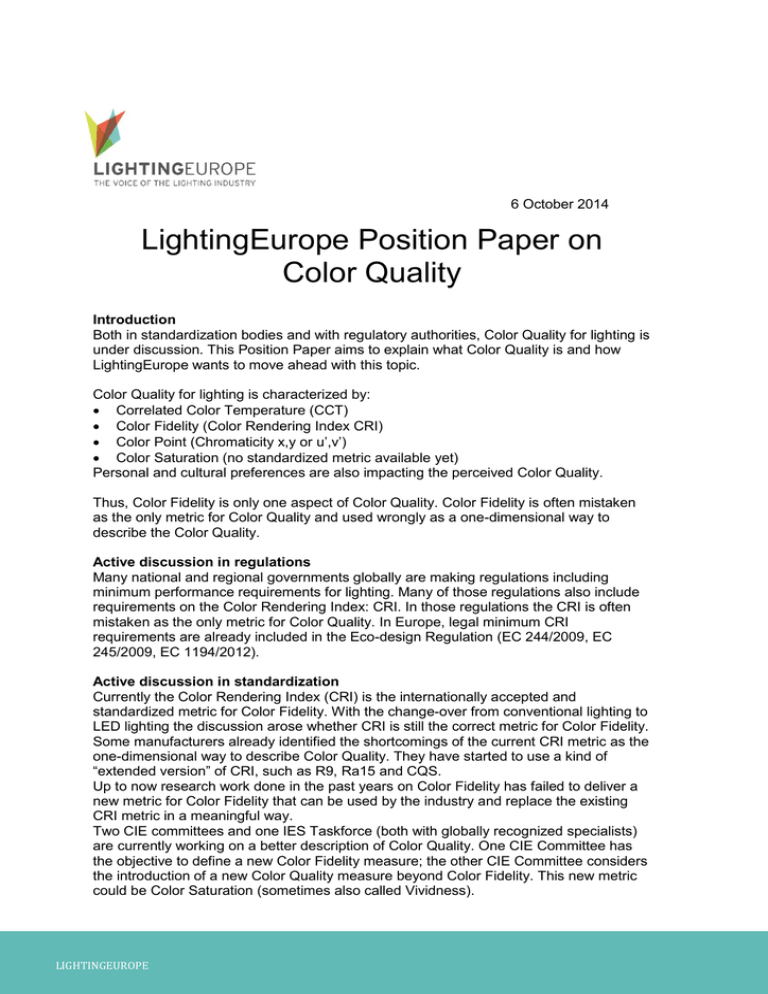LightingEurope Position Paper on Color Quality
advertisement

6 October 2014 LightingEurope Position Paper on Color Quality Introduction Both in standardization bodies and with regulatory authorities, Color Quality for lighting is under discussion. This Position Paper aims to explain what Color Quality is and how LightingEurope wants to move ahead with this topic. Color Quality for lighting is characterized by: Correlated Color Temperature (CCT) Color Fidelity (Color Rendering Index CRI) Color Point (Chromaticity x,y or u’,v’) Color Saturation (no standardized metric available yet) Personal and cultural preferences are also impacting the perceived Color Quality. Thus, Color Fidelity is only one aspect of Color Quality. Color Fidelity is often mistaken as the only metric for Color Quality and used wrongly as a one-dimensional way to describe the Color Quality. Active discussion in regulations Many national and regional governments globally are making regulations including minimum performance requirements for lighting. Many of those regulations also include requirements on the Color Rendering Index: CRI. In those regulations the CRI is often mistaken as the only metric for Color Quality. In Europe, legal minimum CRI requirements are already included in the Eco-design Regulation (EC 244/2009, EC 245/2009, EC 1194/2012). Active discussion in standardization Currently the Color Rendering Index (CRI) is the internationally accepted and standardized metric for Color Fidelity. With the change-over from conventional lighting to LED lighting the discussion arose whether CRI is still the correct metric for Color Fidelity. Some manufacturers already identified the shortcomings of the current CRI metric as the one-dimensional way to describe Color Quality. They have started to use a kind of “extended version” of CRI, such as R9, Ra15 and CQS. Up to now research work done in the past years on Color Fidelity has failed to deliver a new metric for Color Fidelity that can be used by the industry and replace the existing CRI metric in a meaningful way. Two CIE committees and one IES Taskforce (both with globally recognized specialists) are currently working on a better description of Color Quality. One CIE Committee has the objective to define a new Color Fidelity measure; the other CIE Committee considers the introduction of a new Color Quality measure beyond Color Fidelity. This new metric could be Color Saturation (sometimes also called Vividness). LIGHTINGEUROPE The IES Taskforce is currently discussing the option to define a new metric on Color Saturation, next to the metric on Color Fidelity. LightingEurope position on Color Quality 1. LightingEurope supports to continue the use of the existing Color Fidelity metric CRI including eight reference colors. 2. LightingEurope supports to keep legal minimum requirements on CRI on the current level as defined in the EU Eco-design Regulation. Explanation of the LightingEurope position on Color Quality 1. LightingEurope supports to continue the use of the existing Color Fidelity metric CRI including eight reference colors, for the following reasons: Changing of the existing CRI into an index with more or other reference colors will further confuse the market. Consumers are already experiencing two other major changes in lighting: from ‘conventional lighting’ to ‘LED lighting’ and from characterizing a light source by its rated power in ‘Watt’, to characterizing a light source by the light output in ‘lumen’. A new Color Fidelity metric might also negatively impact the conventional lighting business. A new Color Fidelity metric does not solve the lack of a Color Saturation metric. Current insights in a new Color Fidelity metric indicate that the differences with the existing CRI will be only a few points maximum, thus not relevant for industrial purpose and not relevant for the consumers. Therefore, LightingEurope does not support future research on a new Color Fidelity metric, unless there is scientific agreement on a significant and meaningful improvement. A modification of the existing Color Fidelity metric might imply the need to modify existing European lighting standards and regulations that are widely accepted and in use. 2. LightingEurope supports to keep legal minimum requirements on CRI on the current level as defined in the EU Eco-design Regulation. Requiring higher CRI levels for products is not desired for the following reasons: Higher legal minimum requirements on CRI will not result in a higher total Color Quality as Color Fidelity is only one aspect of Color Quality. Higher legal minimum requirements on CRI will block new innovations on the other aspects of Color Quality, such as Color Saturation and personal preference. Higher legal minimum requirements on CRI will in general result in less energy efficient light sources which are contrary to the objective to minimize energy use. LightingEurope is an industry association of 33 European lighting manufacturers, national associations, and companies producing materials. LightingEurope members represent over 1,000 European companies, a majority of which are SMEs; a total workforce of over 100,000 people in Europe; and an annual turnover estimated to exceed 20 billion euros. LightingEurope is dedicated to promoting efficient lighting practices for the benefit of the global environment, human comfort, and the health and safety of consumers. For further information please contact: Anne Vick, Communications Director, LightingEurope, +32 (0)4 797-65-323, anne.vick@lightingeurope.org LIGHTINGEUROPE PAGE 2 OF 2

